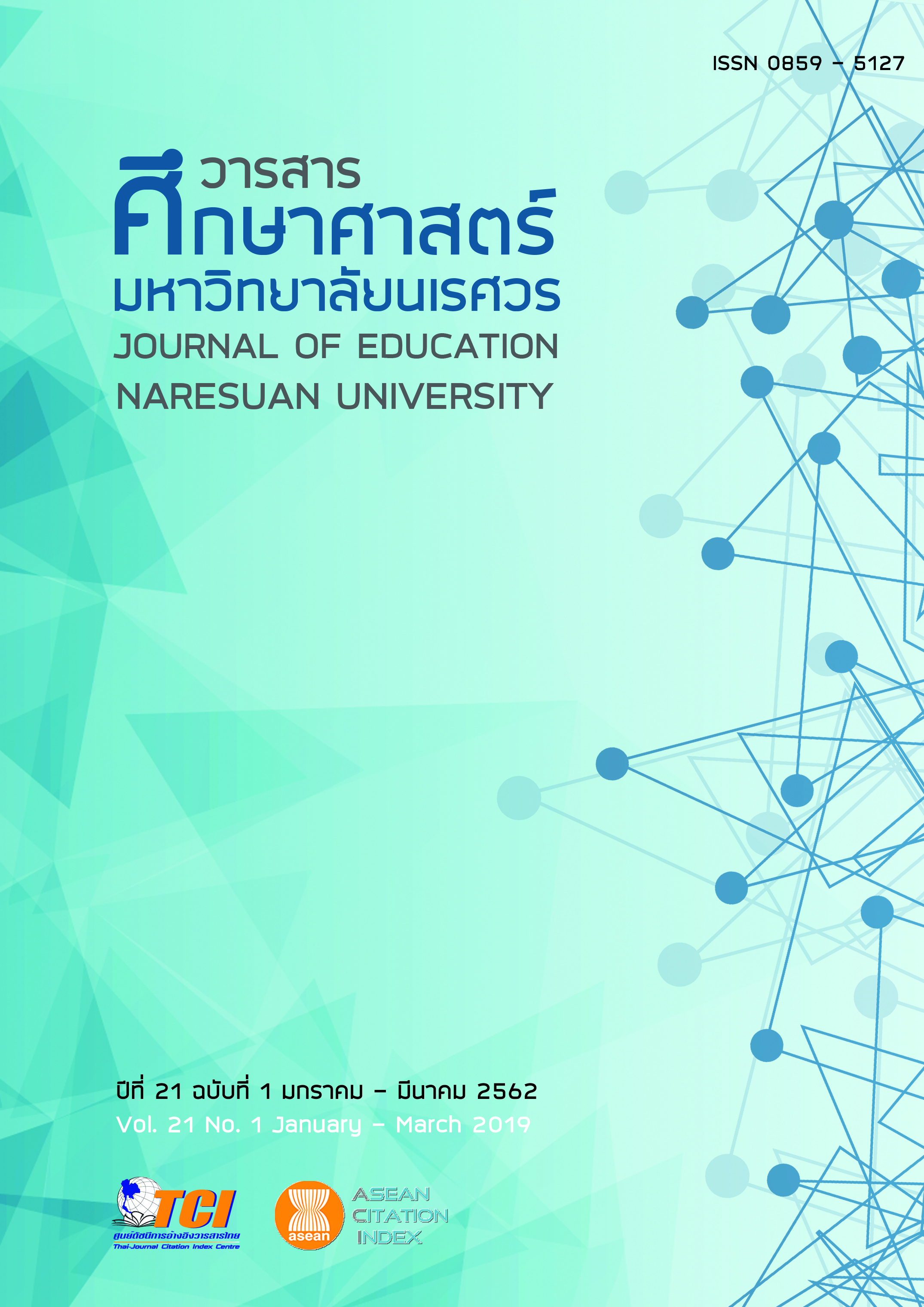รูปแบบการบริหารคุณภาพการฝึกภาคปฏิบัติทางคลินิก สำหรับนักศึกษาพยาบาลในโรงพยาบาล (THE MODEL OF QUALITY MANAGEMENT IN CLINICAL TRAINING FOR NURSING STUDENTS AT HOSPITALS)
Main Article Content
Abstract
การวิจัยครั้งมีวัตถุประสงค์เพื่อพัฒนารูปแบบการบริหารคุณภาพการฝึกภาคปฏิบัติทางคลินิกสำหรับนักศึกษาพยาบาลในโรงพยาบาล ใช้ระเบียบวิธีวิจัยและพัฒนามี 3 ขั้นตอน คือ 1) การศึกษาสภาพและแนวทางการบริหารคุณภาพการฝึกภาคปฏิบัติทางคลินิกโดยการสังเคราะห์เอกสารและการสัมภาษณ์ผู้ทรงคุณวุฒิ 9 คน วิเคราะห์ข้อมูลโดยการวิเคราะห์เนื้อหาและหาข้อสรุป 2) การสร้างรูปแบบการบริหารคุณภาพการฝึกภาคปฏิบัติทางคลินิก โดยนำข้อมูลจากขั้นตอนที่ 1 มายกร่างรูปแบบและตรวจสอบความเหมาะสมของรูปแบบด้วยวิธีสนทนากลุ่มผู้ทรงคุณวุฒิ 9 คน วิเคราะห์ข้อมูลโดยการวิเคราะห์เนื้อหาและหาข้อสรุป และ 3) การประเมินความเป็นไปได้และความมีประโยชน์ของรูปแบบการบริหารคุณภาพการฝึกภาคปฏิบัติทางคลินิก โดยการสำรวจความคิดเห็นของผู้มีส่วนเกี่ยวข้องกับการฝึกภาคปฏิบัติทางคลินิก จำนวน 132 คน วิเคราะห์ข้อมูลโดยการหาค่าเฉลี่ยและส่วนเบี่ยงเบนมาตรฐานและกำหนดเกณฑ์การแปลความหมาย ส่วนคำถามปลายเปิดวิเคราะห์ข้อมูลโดยการวิเคราะห์เนื้อหา ผลการวิจัย พบว่า รูปแบบการบริหารคุณภาพการฝึกภาคปฏิบัติทางคลินิกสำหรับนักศึกษาพยาบาลในโรงพยาบาลประกอบด้วย 3 องค์ประกอบคือ 1) คณะกรรมการดำเนินงานคุณภาพหน่วยฝึกภาคปฏิบัติทางคลินิก 2) การบริหารคุณภาพหน่วยฝึกภาคปฏิบัติทางคลินิก มี 6 องค์ประกอบย่อย ได้แก่ การนำองค์กรหน่วยฝึก การวางแผนยุทธศาสตร์หน่วยฝึก การให้ความสำคัญกับนักศึกษาพยาบาลและผู้มีส่วนได้ส่วนเสีย การวัด การวิเคราะห์และการจัดการความรู้ในหน่วยฝึก การมุ่งเน้นทรัพยากรบุคคลในหน่วยฝึกและการจัดการกระบวนการในหน่วยฝึก ซึ่งมีตัวบ่งชี้ 15 ตัวและตัวบ่งชี้ย่อย 74 ตัว และ 3) ผลลัพธ์การฝึกภาคปฏิบัติทางคลินิก มี 2 องค์ประกอบย่อยได้แก่ ผลลัพธ์ด้านการบริหารคุณภาพและผลลัทธ์ด้านการเรียนรู้ของนักศึกษาพยาบาล โดยมีเครือข่ายความร่วมมือเป็นปัจจัยแห่งความสำเร็จ และผลการประเมินรูปแบบการบริหารคุณภาพการฝึกภาคปฏิบัติทางคลินิกสำหรับนักศึกษาพยาบาลในโรงพยาบาลโดยภาพรวมความเป็นไปได้อยู่ในระดับมาก และความมีประโยชน์อยู่ในระดับมากที่สุด
THE MODEL OF QUALITY MANAGEMENT IN CLINICAL TRAINING FOR NURSING STUDENTS AT HOSPITALS
This research aimed to develop the model of quality management in clinical training for nursing students at hospitals. The methodology used by the researcher followed three steps: 1) studying the state and the guideline of quality management in clinical training consisting of documentary analysis and interview of nine experts. Analyzed data by content analysis and finding conclusion, 2) creating the model of quality management in clinical training based on the information gathered in the first step and validating the model by using a focus group discussion of nine experts. Analyzed data by content analysis and finding conclusion, and 3) assessing its feasibility and usefulness through surveying the opinions of 132 persons involving clinical training for nursing students. Analyzed data by finding the mean and standard deviation and determining the interpretation criteria. For open-ended questions, data analysis by content analysis. The research results revealed that the model of quality management in clinical training for nursing students at hospitals consisted three components: 1) the collaborative committee on quality management in clinical training, 2) clinical training unit management consisting of six subcomponents: a clinical training organization leadership, a strategic planning of clinical training unit, a focus on nursing students and stakeholders, a measurement analysis and knowledge management, a focus on human resources and the process management of clinical training unit with 15 indicators and 74 sub indicators, and 3) the outcome of clinical training consisting of two sub components: a quality management outcome and a nursing students learning outcome. The success of the model depended on the collaborative networks. The feasibility and usefulness of the model of quality management in clinical training for nursing students at hospitals were found to be at high and the highest level.
Article Details
The owner of the article does not copy or violate any of its copyright. If any copyright infringement occurs or prosecution, in any case, the Editorial Board is not involved in all the rights to the owner of the article to be performed.
References
Chatikarn, W. (2012). Managing technic for professional manager in education (3rd ed.). Bangkok: V. Printing. [in Thai]
Kay Edgecombe and Margaret Bowden. (2009). The ongoing search for best practice in clinical teaching and learning: A model of nursing students’ evolution to proficient novice registered nurses. Nurse Education in Practice, 1(9), 91–101.
Kulkliang, P. (2014). Management by committee participation. In P. Waesarat, Administrator training packages: Processing Summary (p. 2). Bangkok: Office of Nation Education Standards and Quality Assessment. [in Thai]
Hiranmaneemas, W. (2013). The development of an administrative model for future technicians organization of Thailand in schools under office of vocational education commission (Doctoral dissertation). Phitsanulok: Naresuan University. [in Thai]
Kunaviktikul, W. (2008). Problem issues for nursing education. In Thailand Nursing and Midwifery council, Collection of 4th Nursing science Education National Conference (pp. 12-13). Bangkok: Samcharernpanich.
Mahasarakham Hospital. (2010). Mahasarakham Hospital order 179/2553: The appointment of developing committee members in medical education center year 2010. Retrieved October 9, 2013, from https://mec.mhkdc.com/commit.html [in Thai]
Metkarunchit, M. (2010). Participating educational administration (3rd ed.) Bangkok: Thairomklao. [in Thai]
Na-Nongkhai, S. (n.d.) Measurement analysis. Retrieved March 10, 2017, from www.navy.mi.th/ncd/main/knowledge/store_knowledge/11008134503/p1R.ppt [in Thai]
Ngernprasertsri, N. (2014). Quality management (2nd ed.). Bangkok: Kasetsart University. [in Thai]
Office of the higher Education Commission. (2011). The guideline for quality assurance in education in higher education institutes year 2010. Bangkok: Parppim Partnership. [in Thai]
Pichaisak, W. (2012). The management of cooperative teaching hospital of orthopedics and physiotherapy department (Research report). Bangkok: Mahidol University. [in Thai]
Pinsakul, N., Wannasri, J., Jansila, V., & Meejang, S. (2014). A participatory management model to promote careers of the student of the school under municipality. Journal of Education Naresuan University, 16(4), 71-81. [in Thai]
Rujkornkarn, D. (2013). Problem issues of nursing education for quality and accessibility of health services. In the Nurses’ Association of Thailand, Collection of 14th Nurses National Conference “Quality and Accessibility of Health Services”: Nurses’ Challenges (pp. 85-91). Nonthaburi: A. P. Graphic Design and Printing. [in Thai]
Sa-nguannam, C. (2008). Theory and practice in educational institution (2nd ed.). Bangkok: Book Point. [in Thai]
Simachokdee, W. (2007). TQM Guigebook to develop organization for excellence. Bangkok: Nation books. [in Thai]
Somdejpraboromratchatevee Sriracha Hospital. (2012). The administrative structure in medical education center of Somdejpraboromratchatevee Sriracha Hospital Year 2012. Retrieved October 9, 2013, from https://www.somdej-mec.or.th/index.mec.or.th/index.php/structor [in Thai]
Sooksriwong, S. (2012). Management: from the executive’s viewpoint (10th ed.). Bangkok: G.P. Ciberprint. [in Thai]
Sunthornnon, N. (2006). Implementing total quality management in Thai public hospitals (Doctoral dissertation). Bangkok: Ramkhamhaeng University. [in Thai]
Vaisurasingha, L., & Chudjuajeen, S. (2008). The development of collaborative model for clinical teaching between Boromarajonani College of Nursing, Suphanburi and Joaphayayommaraj Hospital (Research report). Suphanburi: Boromarajonani College of Nursing, Suphanburi. [in Thai]
Wanasiri, S. (2007). The model of educational quality development by TQM application in Sapanlaugvitthayakom School, Chanthaburi (Master thesis). Songkla: Prince of Songkla University. [in Thai]


